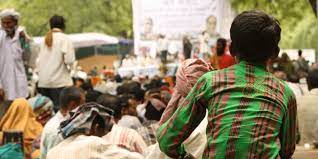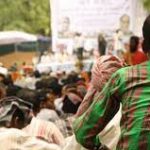Why the Study of Dalit Religions Is Necessary to Understand Hindu Majoritarianism

Based on archival research and ethnography, Joel Lee explores the contradictory nature of the latent and manifest religion of Dalit communities from the 583 clans of the Awadh region.
Suryakant Waghmore
Joel Lee’s book Deceptive Majority is an erudite addition to the study of Indian religions in general and Dalit religions in particular. It charts the complex relationship of Dalits and Dalit religions with Hinduism and Hindu majoritarianism in colonial and postcolonial India.
Based on archival research and ethnography, Lee explores the contradictory nature of latent and manifest religion of sanitation labour castes from the 583 clans of the Awadh region. The book explores the making of the Valmiki identity under colonial modernity of the sanitation labour castes of Awadh.
Hinduism, their declamatory religion, is posed against the Lal Begi tradition that functions as an underground religion. Instead of following the well-trodden and rigid conceptual path of identity and recognition, Lee draws out the conceptual possibilities of pahcha?n and explores the politics of pahcha?n. Pahcha?n is a “distinguishing mark,” a sign by which a person or group is recognised by others
As a concept, then, pahcha?n directs attention to the semiotic terrain on which identitarian struggle takes place and the malleability of the signs on which recognition depends.
Chapter Two is a peek into the pre-enumerative Lal Begi religion of Chuhras (Mehters or Halalkhors). Through his reading of archives, Lee moves beyond the limiting accounts of conversions and syncretism. Lal Begi was indeed asserted as a religion different from Hindus and Muslims and could be easily distinguished in soteriological terms. Hindu and to a certain extent Muslim were terms that were contrasting rather than encompassing Dalit communities. While there was a brotherhood of sorts between Lal Begis and Muslims, the idolatry involved amongst Lal Begis did not make them fellow Muslims.
Broadly this chapter reiterates that Dalits were neither Hindus not Muslims and Lal Begis were not ‘Bal Mikis’. The imperial government’s decision to enumerate ‘untouchables’ as Hindu by default was even opposed by Hindu officials implementing the census initially.
However, the politics of majoritarianism that followed enumerative politics produced Lal Begis and broadly untouchables as Hindus. Outcastes could however generate only ghr?n?a? (disgust) for Hindus and making them Hindus involved purification (shuddhi) and a struggle with ghr?n?a?.
Chapter Three provides deep insights into the politics of shuddhi pursued by the Arya Samaj and Shraddhanand and its critical role in diverting ghr?n?a? towards Muslims while mobilising sympathy towards sanitation castes as Valmikis (long lost brothers). The scavenger castes came to bear lineage with sage Valmiki as part of shuddhi.
While Hinduism is framed as a civil religion under Hindutva in contemporary times (Waghmore, 2022), Lee helps us recollect the foundations of majoritarian politics and processes in Hindu missionary majoritarianism of the Arya Samaj followed by trustee majoritarianism of Gandhi. Arya Samaj’s competition with Christian Missionaries produced shuddhi as an emergent answer where the Gayatri mantra or fire sacrifice could enable the entry of non-Hindus into Arya Dharma.
Chapter Four engages with trustee majoritarianism of Gandhi and the Harijan Sevak Sangh. Gandhi would oppose shuddhi to insist that ‘untouchables’ were always Hindus and there was no need to purify them, scavenging was fulfilment of their caste dharma and that he [pure castes] was the sole trustee of untouchables. For Gandhi, change for outcastes could be driven only by Hindu benevolence and not Depressed Class assertion. Several luminaries including Rabindranath Tagore would join to defend Gandhi.
Meanwhile Gandhi’s Harijan Sevak Sangh, like Shraddhanand, pedalled the myth that Muslims built the latrines and Bhangi was
essentially a recent product of urban life first created by Muslims. The face-off between Ambedkar and Gandhi was also a clash between the assertion of Depressed Classes and Hindu benevolence where Gandhi insisted that Ambedkar in accepting the Poona Pact was also accepting that he and his followers were ‘Hindus’.
The alterity of Lal Begis came under severe check with the Scheduled Caste Order of 1950 as no person who professes a religion different from the Hindu religion was to be deemed a Scheduled Caste. Their Muslim sounding names and Lal Begi religion could not fit the modernist slots of enumeration – Hindu and Muslim. They could either reap benefits of Hindu benevolence or stick to the Lal Begi tradition.
Chapter Five on the making of a Valmiki identity is based primarily on interviews with elderly respondents in Lucknow. Lee suggests that reaping benefits of Hindu benevolence and Hinduisation was not necessarily Sanskritization and the process of Valmikisation was always fraught with the Lal Begi challenge from within. Dissuading scavenger castes from Lal Begi Ummat involved not merely giving up names and old tradition but raking up the cohabitation controversy to ‘reclaim’ scavenger caste women who were either living or married to Muslim men.
Lal Beg came to be Muslim and because Valmikis were not Muslims, they had to therefore dig up shrines of their pir, Lal Beg Sahib. As Lal Begis became Valmikis they also dropped Muslim sounding names so as to be eligible for state education and jobs meant for Scheduled Castes. Hinduisation of Lal Begis encompassed culinary and other aspects of social life and involved conflict between traditionalists and reformists. It was not however a complete Hinduisation or Sanskritisation.
In Chapter Six, Lee’s detailed ethnography elaborates how Hinduism is more of a declamatory religion for scavenger castes in Lucknow meant to reap wages of their limited political inclusion while socially they continue to be excluded. The Jhanki and Valmiki Jayantis of mainstream Hindu parties (Bharatiya Janata Party and Congress) are contrasted in Chapter Seven with the thriving ummat of Lal Beg.
We are provided with ethnographic details of annual Jamghat ritual and celebration of sacrifice where Muslims (Hajjam to Pathan) perform the sacrifice. Lee draws parallels between the underground Lal Begi practices with Taqiyya of Shias, as both are a product of
representational violence. Taqiyya is a belief that allows a follower of Islam to deny their faith in the face of persecution.
Deceit, after all, is essential to human interaction, from the little white lies of which everyday politeness consists to the great collective self-deceptions that enable us to ignore burning contradictions in cultural life. That Taqiyya is more self-aware than some practices of truth concealment does not make it impossible to analyse.
The Orientalist stereotype of Taqiyya as “frivolous hypocrisy,” for its part, can be addressed by critically attending to the conditions of
knowledge production under which it emerged, circulated, and acquired “authority.” The most difficult obstacle to a clear-eyed study of Taqiyya, perhaps, is acknowledging as parochial the moral assumptions about secrecy and publicity that pass as universal in modernity.
In theory, though, just as with other ideological axioms we hold dear, we should be able, having acknowledged them, to suspend the moral assessments they animate for the purposes of analysis. If we do this, we may be able to perceive in the doctrine of Taqiyya something other than what recent centuries of Protestant hegemony have prepared us to perceive. (pp. 270–271)
In the epilogue, Lee emphasises the need to study the everyday production of neighbourliness and the non-commission of violence to understand the quietly thriving neighbourly interdependence. The Indian concept of pahcha?n could indeed help us turn the Euro-American scholarly apparatus upside down.
The experience-near, north Indian vernacular concept of pahcha?n, I have maintained, offers analytical leverage on the actually occurring politics of caste and religion in a way that these ideas of global anglophone social thought do not. […] In an account conceptually guided by pahcha?n, it is possible to see how the majoritarian project can enjoy triumph and suffer defraudment at one
and the same time – these processes develop along divergent semiotic channels; the adept semiotician communicates pahcha?n differently by means of different classes of signs.
Joel Lee’s Deceptive Majority is an excellent contribution to the study of caste, religion, and most of all of one of the most under-studied and marginalised social groups in north India. Outcaste lifeworlds may indeed present critical possibilities for the study of neighbourliness due to the embodied otherness of ‘untouchables’ in relation to Hinduism. Beyond the study of outcastes, what promise and critical insights will the concept of pahcha?n offer in the study of Hinduism and new Hindutva? This remains to be seen.
Suryakant Waghmore is a professor of sociology at IIT Bombay.
Courtesy : The Wire
Note: This news piece was originally published in thewire.com and used purely for non-profit/non-commercial purposes exclusively for Human Right







